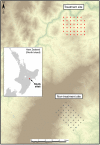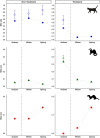Niche partitioning in a guild of invasive mammalian predators
- PMID: 35138656
- PMCID: PMC9285952
- DOI: 10.1002/eap.2566
Niche partitioning in a guild of invasive mammalian predators
Abstract
Predators compete aggressively for resources, establishing trophic hierarchies that influence ecosystem structure. Competitive interactions are particularly important in invaded ecosystems where introduced predators can suppress native prey species. We investigated whether niche partitioning exists within a guild of invasive mammalian predators and determined the consequences for native species. Over 4405 camera-trap days, we assessed interactions among three invasive predators: two apex predators (feral cats Felis catus and ferrets Mustela furo) and a mesopredator (stoats Mustela erminea), in relation to their primary prey (lagomorphs, rodents and birds) and habitat use. Further, we tested for mesopredator release by selectively removing cats and ferrets in a pulse perturbation experiment. We found compelling evidence of niche partitioning; spatiotemporal activity of apex predators maximized access to abundant invasive prey, with ferrets targeting lagomorphs and cats targeting rodents. Mesopredators adjusted their behavior to reduce the risk of interference competition, thereby restricting access to abundant prey but increasing predation pressure on diurnal native birds. Stoats were only recorded at the treatment site after both larger predators were removed, becoming the most frequently detected predator at 6 months post-perturbation. We suggest there is spatial and resource partitioning within the invasive predator guild, but that this is incomplete, and avoidance is achieved by temporal partitioning within overlapping areas. Niche partitioning among invasive predators facilitates coexistence, but simultaneously intensifies predation pressure on vulnerable native species.
Keywords: Carnivora; community ecology; food web; interference competition; invasive species; mustelid; niche differentiation; wildlife management.
© 2022 The Authors. Ecological Applications published by Wiley Periodicals LLC on behalf of The Ecological Society of America.
Conflict of interest statement
The authors declare no conflict of interest.
Figures




References
-
- Alterio, N. , and Moller H.. 1997. “Daily Activity of Stoats (Mustela erminea), Feral Ferrets (Mustela furo) and Feral House Cats (Felis catus) in Coastal Grassland, Otago Peninsula, New Zealand.” New Zealand Journal of Ecology 21: 89–95.
-
- Alterio, N. , Moller H., and Ratz H.. 1998. “Movements and Habitat Use of Feral House Cats Felis catus, Stoats Mustela erminea and Ferrets Mustela furo, in Grassland Surrounding Yellow‐Eyed Penguin Megadyptes antipodes Breeding Areas in Spring.” Biological Conservation 83: 187–94.
-
- Arnold, T. W . 2010. Uninformative parameters and model selection using Akaike's Information Criterion. The Journal of Wildlife Management 74: 1175–78.
-
- Brook, L. A. , Johnson C. N., and Ritchie E. G.. 2012. “Effects of Predator Control on Behaviour of an Apex Predator and Indirect Consequences for Mesopredator Suppression.” Journal of Applied Ecology 49: 1278–86.
-
- Burnham, K. P. , and Anderson D. R.. 2002. Model Selection and Multimodel Inference: A Practical Information‐Theoretic Approach. New York: Springer.
Publication types
MeSH terms
LinkOut - more resources
Full Text Sources
Miscellaneous

